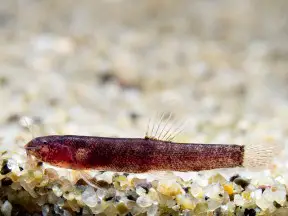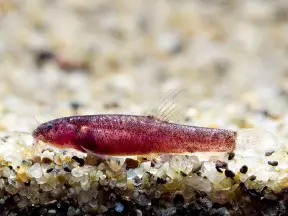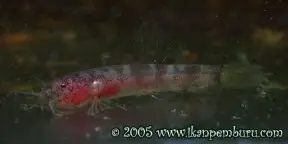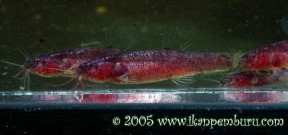Kottelatlimia katik
SynonymsTop ↑
Lepidocephalichthys katik Kottelat & Lim, 1992
Etymology
Kottelatlimia: named for icthyologists Maurice Kottelat and Kelvin K. P. Lim, the authors who originally described K. katik, type species of the genus.
katik: from the Malay katik, meaning ‘short, stunted’, in reference to this species’ small size.
Classification
Order: Cypriniformes Family: Cobitidae
Distribution
This species was described from preserved specimens discovered in a jar with the paratypes of Nagaichthys filipes and thought to originate from Mawai, Johor state, Peninsular Malaysia, and it’s also known from the Batang Hari river drainage, Sumatra, Indonesia.
A similar-looking, possibly undescribed fish is known from the Malaysian state of Sarawak, Borneo.
Habitat
Most commonly found in small, slow-moving forest streams associated with blackwater peat swamps. Such habitats are typically shaded from the sun by marginal vegetation and the dense tree canopy above.
The water generally has a negligible dissolved mineral content, is poorly buffered and pH can be as low as 3.0 or 4.0 due to the gradual release of tannins and organic acids from decaying plant material.
Depending on locality the substrate may be composed of peat, mud or sand with the fish often abundant in piles of leaf litter.
Maximum Standard Length
10 – 13.5 mm.
Aquarium SizeTop ↑
Given its adult size this species could theoretically be kept in a very small volume of water but given its rarity and somewhat specialised needs we wouldn’t recommend anything with base dimensions smaller than 45 ∗ 30 cm.
Maintenance
Not difficult to keep but must be provided with a soft, sandy substrate since some of its time is spent completely buried, or with only eyes protruding. When coarser gravel is used it may become stressed or damage itself trying to dig, and feeding behaviour can be inhibited.
Other décor is not essential but could include water-worn rocks or driftwood branches and tree roots, but be sure to leave open patches of sand between for the fish to move around in.
Lighting can be quite dim unless you intend to grow plants, which should ideally be of species able to grow attached to items of décor, while a few handfuls of dried leaf litter would complete the natural effect and provide additional cover.
Like many fishes that hail from pristine natural habitats it’s intolerant to accumulation of organic wastes and requires spotless water in order to thrive. For this reason it should never be introduced to biologically immature set-ups and adapts most easily to stable, mature aquaria.
Water Conditions
Temperature: 23 – 26 °C
pH: 3.5 – 6.5
Hardness: 0 – 90 ppm
Diet
Chiefly a micropredator sifting mouthfuls of substrate through the gills from which insect larvae, small crustaceans and suchlike are extracted.
In captivity offer a varied diet comprising very fine-grade sinking dried foods plus live and frozen Artemia nauplii, Daphnia, chopped Tubifex, bloodworm, etc. There’s little point offering larger items as it will be unable to ingest them.
Behaviour and CompatibilityTop ↑
Not especially robust and shouldn’t be kept with much larger or more competitive fishes. Small schooling cyprinids are ideal as are anabantoids such as Sphaerichthys or Parosphromenus spp.
If geography isn’t an issue many similarly-sized characins should also work, while other substrate-dwelling loaches could include Pangio, Acanthopsoides or smaller Lepidocephalichthys spp.
Some smaller nemacheilids may also prove suitable but proper research is essential as many can be excessively territorial or otherwise aggressive, require different water conditions or simply grow too large.
Kottelatlimia spp. are peaceful both with one another and other fishes and there exist no reports of them harming tankmates though they may prey on eggs or fry.
They seem to fare best in the presence of conspecifics and should ideally be kept in a group of 4 or more specimens.
Sexual Dimorphism
In mature males the first branched pectoral-fin ray is enlarged with 6-7 fine serrae (spine-like projections) running along the inner edge.
Adult females are typically heavier-bodied and a little larger then males.
Reproduction
Unrecorded in aquaria.
NotesTop ↑
We’re unaware of this species having yet appeared in the aquarium trade although a few private collectors have experience with it.
Among congeners it uniquely possesses a simple suborbital spine and further differs from K. pristes by: smaller adult size (13.5 mm SL vs. 40); presence of a long nasal barbel (vs. absence); anatomy of the modifiedf first branched pectoral-fin ray in males comprising 6-7 fine, narrow serrae (vs. 8-11 pointed, anteriorly-orientated serrae).
In K. hipporhynchos the serrae on the second pectoral ray in males form a broad, contiguous blade-like structure but other differences are the same as for K. pristes.
K. katik is also unique within the genus because it’s considered paedomorphic, or miniaturised, an evolutionary process characterised by sexually mature adults with a significantly reduced size of less than 20 mm SL.
It exhibits some features normally seen in juveniles of other cobitid species such as relatively long fins and long nasal barbels but retains them into adulthood.
Paedomorphic species are also referred to as ‘developmentally truncated’ and are thought to have evolved via a process known as ‘progenetic paedomorphosis’, i.e., paedomorphosis brought about by accelerated maturation. They typically exhibit a simplified skeletal structure along with species-specific morphological peculiarities.
Britz et al. (2009) consider that developmental truncation may have facilitated the development of such novelties ‘by freeing large parts of the skeleton from developmental constraints, dissociating developmentally linked pathways and creating a greater potential for more dramatic changes’.
All known paedomorphic freshwater fishes show a preference for still or slow-moving waters, often in nutrient-poor habitats such as forest peat swamps.
The genus Kottelatlimia was erected by Nalbant (1994) to accommodate K. katik which had previously been assigned to Lepidocephalichthys but differs in various aspects including: relatively small adult size; scaleless head; small eyes; enlarged second pectoral ray in males; possession of nasal barbels.
Lepidocephalichthys pristes was later moved by Kottelat and Whitten (1996) and the grouping currently contains three species following the description of K. hipporhynchos by Kottelat and Tan (2008).
The family Cobitidae, often referred to as ‘true’ loaches, is widely-distributed across most of Eurasia with the Indian subcontinent, Southeast Asia and China representing particular centres of species diversity.
Phylogenetic analyses by Tang et al. (2006), Šlechtová et al. (2007) and Šlechtová et al. (2008) revealed that the group constitutes a separate genetic lineage to the family Botiidae (the two were previously grouped together under Cobitidae as subfamilies Cobitinae and Botiinae).
In the most recent study Lepidocephalichthys was not found to be as closely-related to Pangio, Lepidocephalus or Kottelatlimia as previously hypothesised though unfortunately the authors stop short of proposing an alternative theory.
All cobitids possess sharp, motile, sub-ocular spines which are normally concealed within a pouch of skin but erected when an individual is stressed, e.g. if removed from the water. Care is therefore necessary as these can become entangled in aquarium nets and with larger species even break human skin.
References
- Kottelat, M. and K. K. P. Lim, 1992 - Raffles Bulletin of Zoology 40(2): 201-220
A synopsis of the Malayan species of Lepidocephalichthys, with descriptions of two new species (Teleostei: Cobitidae). - Britz, R. , K. W. Conway, and L. Rüber, 2009 - Proceedings of the Royal Society of London, Series B - Biological Sciences 276: 2179-2186
Spectacular morphological novelty in a miniature cyprinid fish, Danionella dracula n. sp. - Kottelat, M., 2012 - Raffles Bulletin of Zoology Supplement 26: 1-199
Conspectus cobitidum: an inventory of the loaches of the world (Teleostei: Cypriniformes: Cobitoidei). - Kottelat, M., 2013 - Raffles Bulletin of Zoology Supplement 27: 1-663
The fishes of the inland waters of southeast Asia: a catalogue and core bibliography of the fishes known to occur in freshwaters, mangroves and estuaries. - Kottelat, M. and H. H. Tan, 2008 - Zootaxa 1967: 63-72
Kottelatlimia hipporhynchos, a new species of loach from southern Borneo (Teleostei: Cobitidae). - Nalbant, T., 1994 - Travaux du Muséum d'Histoire Naturelle 'Grigore Antipa' 34: 375-380
Studies on loaches (Pisces: Ostariophysi; Cobitoidea). I. An evaluation of the valid genera of Cobitinae. - Roberts, T. R., 1989 - Memoirs of the California Academy of Sciences 14: i-xii + 1-210
The freshwater fishes of western Borneo (Kalimantan Barat, Indonesia). - Tan, H. H., and M. Kottelat, 2009 - Ichthyological Exploration of Freshwaters 20(1): 13-69.
The fishes of the Batang Hari drainage, Sumatra, with description of six new species. - Tang, Q., H. Liu, R. Mayden and B. Xiong, 2006 - Molecular Phylogenetics and Evolution 39(2): 347-357
Comparison of evolutionary rates in the mitochondrial DNA cytochrome b gene and control region and their implications for phylogeny of the Cobitoidea (Teleostei: Cypriniformes). - Šlechtová, V., J. Bohlen and A. Perdices, 2008 - Molecular Phylogenetics and Evolution 47(2): 812-831
Molecular phylogeny of the freshwater fish family Cobitidae (Cypriniformes: Teleostei): delimitation of genera, mitochondrial introgression and evolution of sexual dimorphism. - Šlechtová, V., J. Bohlen and H. H. Tan, 2007 - Molecular Phylogenetics and Evolution 44(3): 1358-1365
Families of Cobitoidea (Teleostei; Cypriniformes) as revealed from nuclear genetic data and the position of the mysterious genera Barbucca, Psilorhynchus, Serpenticobitis and Vaillantella.






